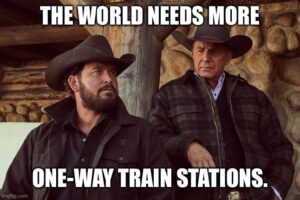Some people think marketing is simply commercials or ads. They consider it to be some form of paid promotion and nothing else. In their minds, marketing and advertising are the same things, interchangeable words.

We all thought blogging and social media would change all that. These new platforms were going to swoop in and save us from all of these ads. Ahh, nope.
Now we have native advertising, paid blogs. We have promoted posts on all of the social media platforms. The fat cats with all the money keep ruining everything!
With each new technology and platform, we’re convinced that marketing will forever change. In some ways it does, but mostly it stays true to what it really is.
What is Marketing?
According to the American Marketing Association, marketing is…
The activity, set of institutions, and processes for creating, communicating, delivering, and exchanging offerings that have value for customers, clients, partners, and society at large.
Advertising will always be a part of marketing. But, is marketing advertising? The word “value” in that definition is what I want to talk about.
The other day I was watching Yellowstone with my wife. Rip is an awesome character but I liked that actor better as Benny in Dazed and Confused.

Anyway, there was this really touching scene with Rip and Beth on Rip’s new front porch. Beth walks away and Rip is just sitting there on the steps watching the sunset. Next to him is a perfectly placed Yeti cooler.
We can monetize anything. I’d get a swoosh on my forehead if Nike paid me enough. But, what value does that have for society at large?

None really, people will just say “look that idiot has a big swoosh on his forehead. Nike is shameless.”
So, sure, you can pay to play. You can pay for position, attention, traffic, etc. But advertising is always going to be money in, money out. Advertising has its place but it’s not sustainable without a steady stream of money.
Good Marketing Builds Trust
When is the last time you trusted a company more because of a commercial? I’m sure it’s happened but I’m certain it’s rare.
As I’ve stated in many a presentation, good marketing is about three things…
- Being Known
- Being a Resource
- Being Trusted (there goes the little green smiley face from Yoast, oh well, a little inside baseball, sorry)
Let’s look at each of these.
Being Known
Mark Schaefer wrote a great book titled Known that talks about this very concept. We don’t market out of the goodness of our hearts, but we certainly need to think about how we’d like our organization to be known.
And we also simply need to be known. As I discuss a bit in my last post about influencer marketing, influencers want to work with brands that are known.
Well, customers want to buy from brands they know. If they don’t know you, they will ask their friends, colleagues, etc if any of them know you. And where do they ask?
- On social media
- In email and text
- In-person (not so much these days)
- On the phone (I think people still make actual calls)
- On video calls (shall we Zoom?)
Make sure you have a solid presence on social media and that you engage with your followers. Be in their inbox with helpful information, news they need, and timely tips.
At a minimum, to be known, you’ll need to do the following…
- Social media marketing
- Content marketing (including blogs, white papers, case studies)
- Email marketing (with marketing automation if possible)
- SEO
Maintain a consistent, positive, and resourceful presence in the lives of your customers and in the lives of those in a position to recommend your services.
Of course, advertising can help you become known, but what are you known for? Commercials.
You want to be known for more than just your brand or your clever ads. Which brings us to point two…
Being a Resource
One of my favorite quotes that I use constantly is from my friend, Ann Handley. To know Ann is to love Ann. 🙂

Anyway, the quote goes like this…
“Be relentlessly customer-focused and not corporate-focused. Ask yourself, as a marketer…‘What marketing will my customer THANK me for?’” – Ann Handley, CCO at MarketingProfs, Author of Content Rules and Everybody Writes
Think about that for a minute, marketing your customer will thank you for. That doesn’t seem like something most marketers might consider. Mostly, their number one concern is the bottom line.
People remember when you help them. They feel a sense of loyalty to those who were there for them. This is true for marketing as well.
For example, your content marketing efforts shouldn’t only be about SEO (although that is part of it). Content marketing should focus on utility – content that your target audience can use and share.
Utility Content
I’ve been talking about utility content for years now. It’s still a very important element of content marketing. Utility content can be any or all of the following…
- How-to videos
- Interviews with experts containing actionable tips
- Thought-provoking posts that help someone solve a problem
- Tools, references, studies, eBooks, white papers
- Newsjacking, using a current event to illustrate a point
Don’t get overwhelmed. There is content for you everywhere. Read this post for more on content inspiration.
There are more examples of utility content. Don’t get bogged down on what it is, instead focus on why it’s important. It’s important because you are using this utility content to be there in your customer’s time of need.
When you become their go-to resource, you build trust.
Being Trusted
Trust comes from empathy (Scott Monty and I discuss this at length in this Wellspring Digital Chat). Your customers want to know that you truly understand them, not just from a demographics standpoint, but that you truly understand who they are.
So, who is your client? You have two choices here. You can go the simple route and develop some client characters, a fictional depiction of a real client.
Or, you can actually profile a real customer. These are called Buyer Personas. I highly recommend heading over to Adele Revella’s group, the Buyer Persona Institute, for a deep dive into what these are and how they can help.
For the purposes of this post, I want to give you the basics. Ultimately, you are interviewing different clients to develop a user profile. If you know anything about UX, this should seem familiar to you.
A Very Quick Buyer Persona Activity
Set up a call with a real client. Let them know you’re looking to gain a better understanding of their needs. Keep it brief and focused. Then, center on a specific experience they’ve had with you and ask them the following…
- Motivations – What drove them to take action and begin this journey?
- Goals – What did they want to accomplish?
- Expectations – How did they envision the journey? Did reality match expectations?
- Behavior – How did they interact with your organization (in person, through an ad, on your website, on social)? What was their state of mind (busy, angry, happy, frantic, etc.)?
Listening to real clients tell you about their experience working with you will help you to change your mindset. You are now able to understand them and truly empathize with their situation.
Marketing Beyond Advertising
Now, you are able to create marketing that they will thank you for, marketing that builds trust instead of advertising that’s just noise. You’re building trust by developing marketing initiatives that actually help them in their time of need.
Everything you give them should…
- Offer them value
- Be easy to understand and actionable
- Be shareable
- Use language they understand
- Have no strings attached
- Be authentic, this post about Core Values might help
What you do with your marketing from this point forward will determine if you are known, a valued resource, and trusted. Remember, there is no trust without action…
- Create good content that they can use.
- Get it out to them through smart sharing.
- Create a customer experience that delivers value.
- Value builds trust!
- Trust leads to shares, links, and a following!
- This brings leads, customers, and builds your bottom line.
See? You can still build your bottom line, but you have to focus on the customer first and foremost. They will reward you with their trust, their referrals, and their repeat business.
Need help with social media marketing, content marketing, SEO, heck, even ads. Drop us a line or give us a call at 717.457.0522.